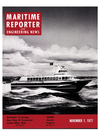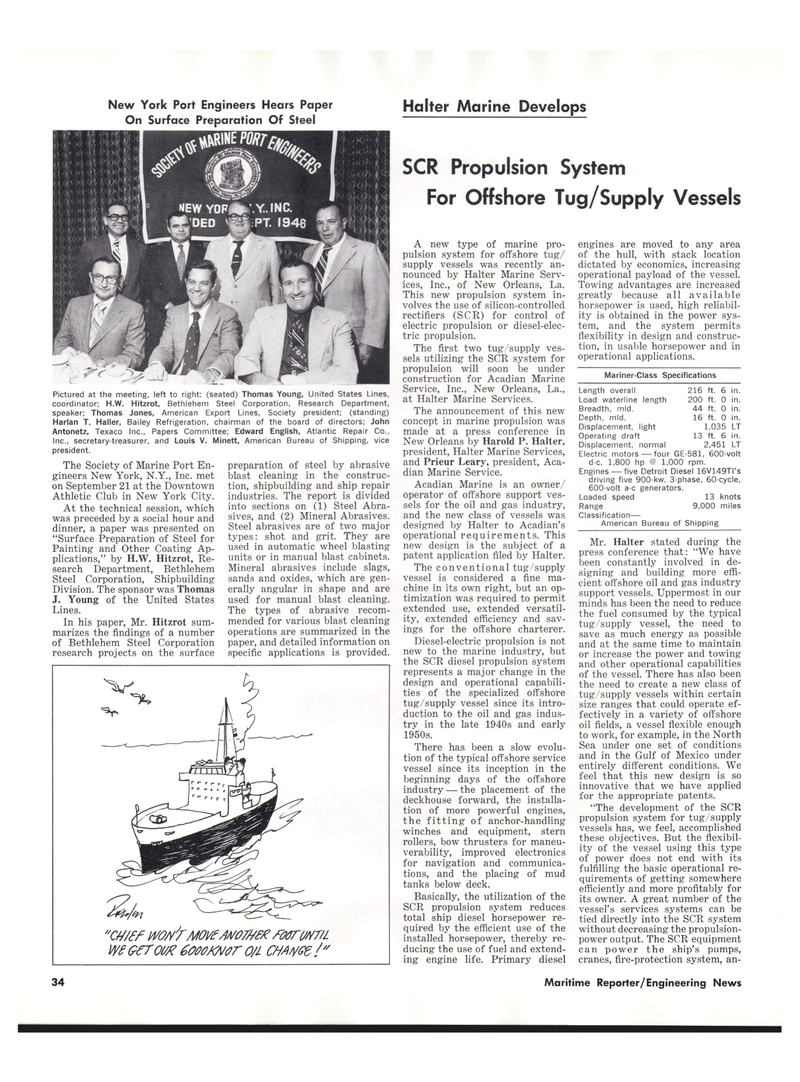
Page 34: of Maritime Reporter Magazine (November 1977)
Read this page in Pdf, Flash or Html5 edition of November 1977 Maritime Reporter Magazine
New York Port Engineers Hears Paper
On Surface Preparation Of Steel
Pictured at the meeting, left to right: (seated) Thomas Young, United States Lines, coordinator; H.W. Hitzrot, Bethlehem Steel Corporation, Research Department, speaker; Thomas Jones, American Export Lines, Society president; (standing)
Harlan T. Haller, Bailey Refrigeration, chairman of the board of directors; John
Antonetz, Texaco Inc., Papers Committee; Edward English, Atlantic Repair Co.,
Inc., secretary-treasurer, and Louis V. Minett, American Bureau of Shipping, vice president.
The Society of Marine Port En- gineers New York, N.Y., Inc. met on September 21 at the Downtown
Athletic Club in New York City.
At the technical session, which was preceded by a social hour and dinner, a paper was presented on "Surface Preparation of Steel for
Painting and Other Coating Ap- plications," by H.W. Hitzrot, Re- search Department, Bethlehem
Steel Corporation, Shipbuilding
Division. The sponsor was Thomas
J. Young of the United States
Lines.
In his paper, Mr. Hitzrot sum- marizes the findings of a number of Bethlehem Steel Corporation research projects on the surface
Halter Marine Develops
SCR Propulsion System
For Offshore Tug/Supply Vessels preparation of steel by abrasive blast cleaning in the construc- tion, shipbuilding and ship repair industries. The report is divided into sections on (1) Steel Abra- sives, and (2) Mineral Abrasives.
Steel abrasives are of two major types: shot and grit. They are used in automatic wheel blasting units or in manual blast cabinets.
Mineral abrasives include slags, sands and oxides, which are gen- erally angular in shape and are used for manual blast cleaning.
The types of abrasive recom- mended for various blast cleaning operations are summarized in the paper, and detailed information on specific applications is provided.
A new type of marine pro- pulsion system for offshore tug/ supply vessels was recently an- nounced by Halter Marine Serv- ices, Inc., of New Orleans, La.
This new propulsion system in- volves the use of silicon-controlled rectifiers (SCR) for control of electric propulsion or diesel-elec- tric propulsion.
The first two tug/supply ves- sels utilizing the SCR system for propulsion will soon be under construction for Acadian Marine
Service, Inc., New Orleans, La., at Halter Marine Services.
The announcement of this new concept in marine propulsion was made at a press conference in
New Orleans by Harold P. Halter, president, Halter Marine Services, and Prieur Leary, president, Aca- dian Marine Service.
Acadian Marine is an owner/ operator of offshore support ves- sels for the oil and gas industry, and the new class of vessels was designed by Halter to Acadian's operational requirements. This new design is the subject of a patent application filed by Halter.
The conventional tug/supply vessel is considered a fine ma- chine in its own right, but an op- timization was required to permit extended use, extended versatil- ity, extended efficiency and sav- ings for the offshore charterer.
Diesel-electric propulsion is not new to the marine industry, but the SCR diesel propulsion system represents a major change in the design and operational capabili- ties of the specialized offshore tug/supply vessel since its intro- duction to the oil and gas indus- try in the late 1940s and early 1950s.
There has been a slow evolu- tion of the typical offshore service vessel since its inception in the beginning days of the offshore industry — the placement of the deckhouse forward, the installa- tion of more powerful engines, the fitting of anchor-handling winches and equipment, stern rollers, bow thrusters for maneu- verability, improved electronics for navigation and communica- tions, and the placing of mud tanks below deck.
Basically, the utilization of the
SCR propulsion system reduces total ship diesel horsepower re- quired by the efficient use of the installed horsepower, thereby re- ducing the use of fuel and extend- ing engine life. Primary diesel engines are moved to any area of the hull, with stack location dictated by economics, increasing operational payload of the vessel.
Towing advantages are increased greatly because all available horsepower is used, high reliabil- ity is obtained in the power sys- tem, and the system permits flexibility in design and construc- tion, in usable horsepower and in operational applications.
Mariner-Class Specifications
Length overall 216 ft. 6 in.
Load waterline length 200 ft. 0 in.
Breadth, mid. 44 ft. 0 in.
Depth, mid. 16 ft. 0 in.
Displacement, light 1,035 LT
Operating draft 13 ft. 6 in.
Displacement, normal 2,451 LT
Electric motors — four GE-581, 600-volt d-c, 1,800 hp @ 1,000 rpm.
Engines — five Detroit Diesel 16V149TI's driving five 900-kw, 3-phase, 60-cycle, 600-volt a-c generators.
Loaded speed 13 knots
Range 9,000 miles
Classification—
American Bureau of Shipping
Mr. Halter stated during the press conference that: "We have been constantly involved in de- signing and building more effi- cient offshore oil and gas industry support vessels. Uppermost in our minds has been the need to reduce the fuel consumed by the typical tug/supply vessel, the need to save as much energy as possible and at the same time to maintain or increase the power and towing and other operational capabilities of the vessel. There has also been the need to create a new class of tug/supply vessels within certain size ranges that could operate ef- fectively in a variety of offshore oil fields, a vessel flexible enough to work, for example, in the North
Sea under one set of conditions and in the Gulf of Mexico under entirely different conditions. We feel that this new design is so innovative that we have applied for the appropriate patents. "The development of the SCR propulsion system for tug/supply vessels has, we feel, accomplished these objectives. But the flexibil- ity of the vessel using this type of power does not end with its fulfilling the basic operational re- quirements of getting somewhere efficiently and more profitably for its owner. A great number of the vessel's services systems can be tied directly into the SCR system without decreasing the propulsion- power output. The SCR equipment can power the ship's pumps, cranes, fire-protection system, an- 34 Maritime Reporter/Engineering • News

 33
33

 35
35
